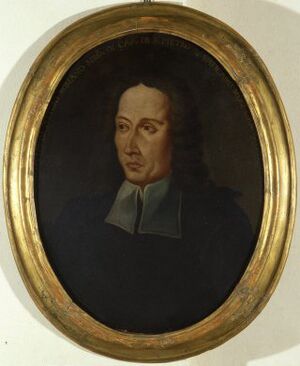Giuseppe Ottavio Pitoni facts for kids
Giuseppe Ottavio Pitoni (born in Rieti, Italy, on March 18, 1657 – died in Rome, Italy, on February 1, 1743) was a famous Italian organist and composer. He became one of the most important musicians in Rome during the late Baroque period, which was the first half of the 1700s.
Life of a Musical Master
Giuseppe Pitoni moved to Rome when he was just a baby. He started learning to sing at age five with Pompeo Natali. By age eight, he was singing in the choir at San Giovanni dei Fiorentini. At another church, Santi Apostoli, he sang and studied how to write music with Francesco Foggia. His first musical pieces were even performed there!
When he was only sixteen, Pitoni became the maestro di cappella (which means "master of the chapel" or music director) at Santa Maria Maggiore in Monterotondo, a historic church near Rome. In 1673, he became the music director for the cathedral in Assisi. There, he spent a lot of time studying the music of Palestrina, another very famous composer. In 1676, Pitoni moved to the cathedral in Rieti.
In 1677, he returned to Rome and got a job that would last his whole life: maestro di cappella at the Basilica of San Marco. He also held many other important music director jobs. These included positions at the Basilica dei Santi Apostoli, Rome (starting in 1686), at St. John Lateran (from 1708, where Palestrina had also worked), and for the Cappella Giulia at St. Peter’s (from 1719, right after Domenico Scarlatti). He was also the music director at the Collegium Germanicum in Rome. For over 35 years, he created major musical performances for Cardinal Pietro Ottoboni, who loved music. The Cardinal's group of artist friends included other famous musicians like Arcangelo Corelli, George Frideric Handel, Alessandro and Domenico Scarlatti, and Bernardo Pasquini.
Pitoni's Music
Pitoni made huge contributions to church music in Rome. He was a composer, an organist, a music director, and even wrote about music history and how music works. He also helped examine other music teachers for the Academy of St. Cecilia.
He wrote an incredible amount of music! His student and biographer, Girolamo Chiti, listed about 3,500 compositions. These included around 325 masses (music for church services), 800 Psalm settings, and 235 motets (short pieces of sacred choral music). He even prepared all the music needed for every Sunday and holy day at St. Peter’s Basilica for an entire year.
Pitoni's early music showed his amazing talent in the Roman style of writing music where different voice parts weave together, similar to Palestrina's work. Later in his life, he started using more simple, chord-based music with parts for multiple choirs singing from different places. He also used a style called stile concertato, which included solo singing parts and instrumental parts.
It is said that Pitoni was so skilled he could compose the parts for a 16-voice mass separately, without needing a full musical score. When his music was performed in the large, echoey churches of Rome, with singers adding their own decorations and instruments playing along, it must have sounded very powerful and impressive. At the end of his life, he was working on a mass for twelve choirs, but he passed away before finishing it. He was buried in his family's tomb in the Basilica of San Marco, where he had worked for about 66 years.
His most famous work is the Dixit Dominus for 16 voices in 4 choirs.
Music Writings and Recordings
Many of Pitoni's handwritten musical pieces are kept in the library of the Cappella Giulia in Rome and the Bibliotheca Santini in Münster.
Some of his well-known works include:
- Cantate Domino
- Laudate Dominum
- Dixit Dominus (which has been recorded by groups like the Tölzer Knabenchor with Gerhard Schmidt-Gaden)


